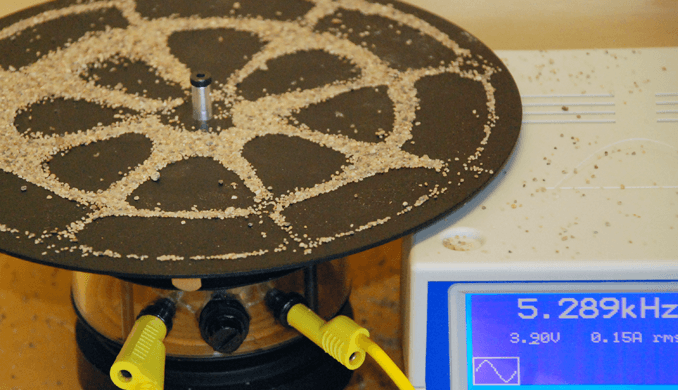Go where the music takes you!
September 13, 2016
on
on

You probably already know of the beautiful designs obtained with sand on a vibrating plate. Since the experiments at the beginning of the nineteenth century by Ernst Chladni (1756-1827), German physicist and astronomer, considered the father of modern acoustics, it was generally thought that the movement of the grains of sand, before settling in positions determined by the nodal lines of the vibrations, was random. But these movements are predictable and have allowed the researchers at the University of Aalto (Finland) to use the same transducer to control the movements of several different object on a vibrating plate – up to six at the time of writing.
A computer with a camera analyses the movements of the objects being followed on a vibrating plate which is driven by a certain frequency. By modifying the frequency of the vibrations, the computer can change the direction of each object. This control loop with regulation by different frequencies results in predictable sequences of movement.
This method allows the manipulation without touching of various small objects of different type, weight and size, such as microelectronic components, droplets of water, seeds, candy or larger pieces of metal. Among the practical applications foreseen by the researchers are the transport and sorting of integrated circuits or medical substances, or the separation of small volumes of liquids. The principle of control of movement by vibrating waves can also be applied to liquid mediums for control of the movement of floating objects.
A computer with a camera analyses the movements of the objects being followed on a vibrating plate which is driven by a certain frequency. By modifying the frequency of the vibrations, the computer can change the direction of each object. This control loop with regulation by different frequencies results in predictable sequences of movement.
This method allows the manipulation without touching of various small objects of different type, weight and size, such as microelectronic components, droplets of water, seeds, candy or larger pieces of metal. Among the practical applications foreseen by the researchers are the transport and sorting of integrated circuits or medical substances, or the separation of small volumes of liquids. The principle of control of movement by vibrating waves can also be applied to liquid mediums for control of the movement of floating objects.
Read full article
Hide full article


Discussion (0 comments)